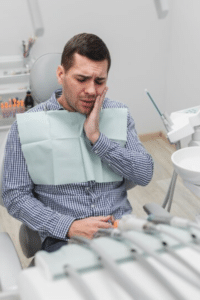Our mouths are a marvel of engineering. From the gnashing power of our molars to the intricate dance of tongue and teeth, they help us savor delicious food, communicate clearly, and even boost our confidence with a winning smile. But just like any complex system, our teeth and gums are susceptible to problems. While some dental issues can wait for a scheduled appointment, others require immediate attention. Ignoring a potential emergency can lead to worsening pain, infection, and even tooth loss. So, how do you know when a trip to the dentist can’t wait? This blog dives into the 4 key signs that scream “dental emergency” and what steps to take to get the prompt care your smile needs.
#1: The Throbbing Toothache: A Persistent and Unrelenting Pain
Toothaches are a common dental nuisance, but some are far worse than others. A dull ache might be a minor annoyance, but a throbbing toothache is a persistent and unrelenting pain that can disrupt your entire life. Imagine a rhythmic pounding deep within your jaw, a relentless intruder that won’t let you sleep, focus, or even enjoy a simple meal. This kind of throbbing toothache is a serious warning sign and shouldn’t be ignored.
Potential Culprits Behind the Throbbing Torment
An Abscessed Tooth: This is a dental emergency, not to be trifled with. An abscess is a severe infection at the root of the tooth, where the pulp (containing nerves and blood vessels) resides. This infection can cause excruciating pain, often accompanied by:
- Throbbing that intensifies with pressure (chewing, biting)
- Throbbing pain that radiates to your jaw, ear, or even neck
- Visible swelling in your face or cheek
- Sensitivity to hot and cold temperatures
- Fever and chills
- Bad breath with a foul taste
Pulpitis: The inner pulp of your tooth is a vital part containing nerves and blood vessels. When this pulp becomes inflamed (pulpitis), the throbbing pain can be intense. This inflammation can be caused by:
- Deep cavities that reach the pulp
- Trauma to the tooth
- Repeated dental procedures on the same tooth
Cracked Tooth: A hidden fracture in your tooth, especially one that extends to the pulp, can cause severe throbbing pain, particularly when you chew or apply pressure. You might also experience sharp shooting pains.
#2: Knocked-Out Tooth: Time is of the Essence!
A knocked-out tooth is considered a dental emergency for a few key reasons:
Time is of the essence: The quicker you act, the higher the chance of successfully reimplanting the tooth. The longer the tooth is out of the socket, the lower the chances of survival due to the drying out of the root and damage to the ligament that holds the tooth in place.
Infection risk: An empty socket is an open door for bacteria to enter the jawbone and bloodstream, potentially leading to serious infections.
Bone loss: The bone surrounding the tooth starts to deteriorate without the stimulation provided by the tooth root. This can make reimplantation more difficult later or even impossible.
Adjacent teeth: The surrounding teeth may shift to fill the gap left by the missing tooth, causing misalignment and bite problems.
Long-term consequences: Losing a permanent tooth can lead to a cascade of issues. This includes difficulty chewing and speaking, digestive problems, and even changes in facial structure.

#3: Uncontrollable Bleeding and Swollen Gums
Healthy gums are the foundation of a confident smile and a key player in your overall well-being. Ideally, your gums should be a firm, pale pink color and shouldn’t bleed easily. But if you’ve been noticing uncontrollable bleeding, particularly heavy or continuous, along with swollen and inflamed gums, it could be a sign of gum disease. Here’s a deeper look at what uncontrolled bleeding and swollen gums might be telling you:
Inflammation on High Alert: Uncontrolled bleeding is a red flag (pun intended) that something is irritating and inflaming your gum tissue. This inflammation is often caused by a buildup of plaque, a sticky film teeming with bacteria, at the gumline. When left undisturbed, plaque hardens into tartar, creating a shield for bacteria to wreak havoc further.
The Breakdown of Trust: As the plaque and tartar buildup, they create a deeper gap between your gum tissue and teeth. This breakdown in the healthy seal between gum and tooth allows bacteria to invade and multiply, further worsening the inflammation and leading to the breakdown of the bone that supports your teeth.
Swollen and Sore: The inflamed gum tissue becomes puffy, red, and painful. This swelling and discomfort can make brushing and flossing even more challenging, creating a vicious cycle. You might also experience increased sensitivity to hot and cold foods or drinks.
#4: A Broken or Lost Filling or Crown
Fillings and crowns are the loyal guardians of your smile, acting as shields against decay and damage. But even the sturdiest guards can face challenges. A broken or lost filling or crown can leave your tooth exposed and vulnerable, creating a situation that demands prompt attention. Let’s delve deeper into why a chipped filling or a missing crown shouldn’t be ignored:
Painful Sensitivity: Beneath the hard enamel exterior of your tooth lies the dentin, a layer packed with tiny nerve endings. A broken filling creates a direct pathway for extreme hot or cold to reach these nerves, causing sharp pangs of sensitivity.
Increased Risk of Infection: Bacteria constantly lurk in your mouth, and a compromised filling provides them with an open invitation to invade the inner pulp of your tooth. This can lead to a painful infection, potentially causing swelling, throbbing pain, and even fever.
Further Tooth Damage: Exposures to extreme temperatures and constant bacterial assault can weaken the remaining tooth structure. This can lead to cracks, fractures, and even complete tooth loss if left untreated.
Crowns: The Protectors Under Threat: Crowns are often placed on teeth that have undergone significant damage or root canal procedures. A loose or lost crown leaves the underlying tooth structure vulnerable to all the threats mentioned above, putting the health of the tooth at risk.
Chewing Discomfort: Fractures or missing parts in fillings and crowns can disrupt the smooth surface needed for proper chewing. This can lead to discomfort and difficulty enjoying your favorite foods.
Ignoring dental problems can lead to more serious issues down the line. By recognizing the four signs mentioned earlier – you can seek prompt emergency dental attention. Early intervention can minimize pain, prevent complications, and potentially save your tooth. Remember, a quick call to your dentist or a visit to an emergency dental clinic can make all the difference. So prioritize your oral health, and don’t hesitate to seek the professional care you deserve.



